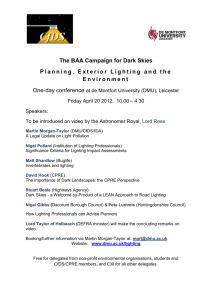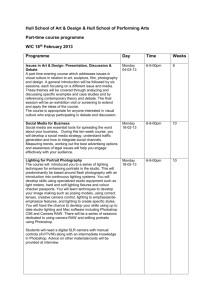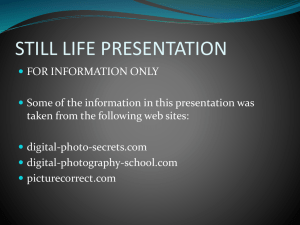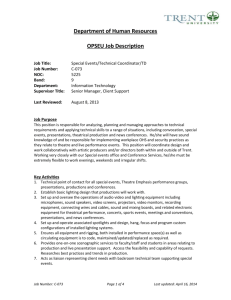COMMISSION REGULATION (EU) …/… of XXX implementing
advertisement
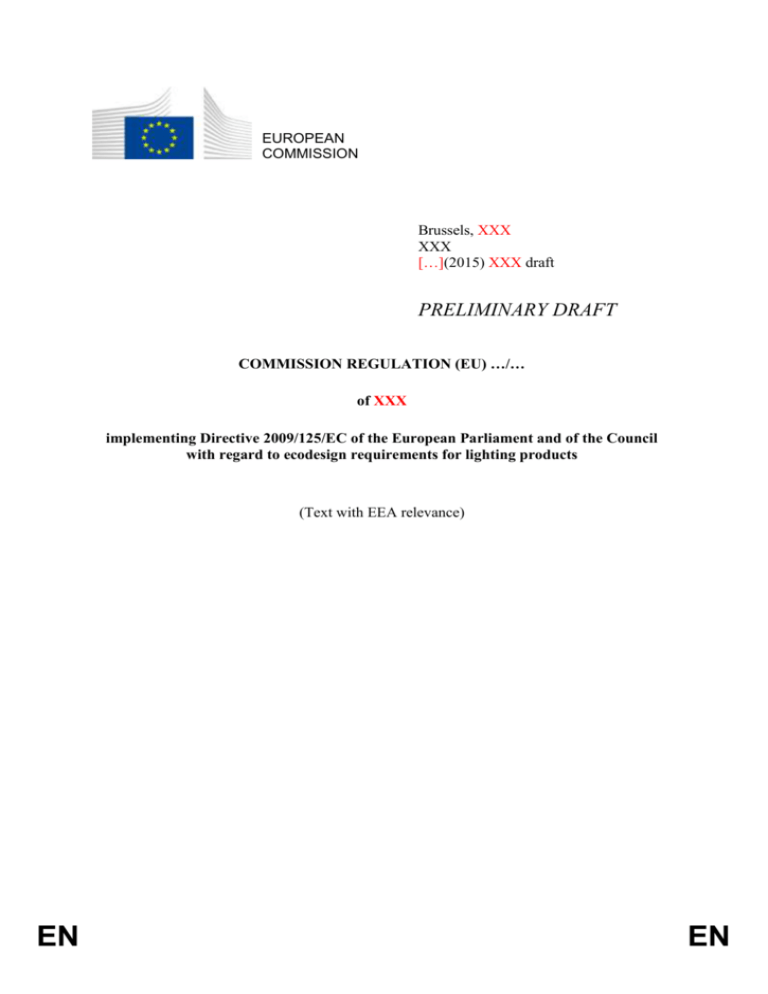
EUROPEAN COMMISSION Brussels, XXX XXX […](2015) XXX draft PRELIMINARY DRAFT COMMISSION REGULATION (EU) …/… of XXX implementing Directive 2009/125/EC of the European Parliament and of the Council with regard to ecodesign requirements for lighting products (Text with EEA relevance) EN EN COMMISSION REGULATION (EU) …/… of XXX implementing Directive 2009/125/EC of the European Parliament and of the Council with regard to ecodesign requirements for lighting products (Text with EEA relevance) THE EUROPEAN COMMISSION, Having regard to the Treaty on the Functioning of the European Union, Having regard to Directive 2009/125/EC of the European Parliament and of the Council of 21 October 2009 establishing a framework for the setting of ecodesign requirements for energyrelated products (1), and in particular Article 15(1) thereof, After consulting the Ecodesign Consultation Forum, Whereas: (1) Directive 2009/125/EC requires the Commission to set ecodesign requirements for energy-related products representing significant volumes of sales and trade, having a significant environmental impact and presenting significant potential for improvement through design in terms of their environmental impact, without entailing excessive costs. (2) Article 16(2)(a) of Directive 2009/125/EC provides that in accordance with the procedure referred to in Article 19(3) and the criteria set out in Article 15(2), and after consulting the Ecodesign Consultation Forum, the Commission has to, as appropriate, introduce implementing measures that offer a high potential for cost-effective reduction of greenhouse gas emissions, such as lighting products and components. (3) The Commission has carried out a preparatory study to analyse the technical, environmental and economic aspects of lighting products and components. The study has been developed together with stakeholders and interested parties from the Union and third countries, and the results have been made publicly available. (4) This preparatory study builds upon and reviews the regulatory requirements introduced through Commission Regulation (EC) No 244/2009 (2), Commission Regulation (EC) No 245/2009 (3) and Commission Regulation (EU) No 1194/2012 (4). The results of this study show the benefit of continued and improved requirements, adapted in stringency to the technological progress of lighting products and components. (5) The environmental aspects of the lighting products and components covered that have been identified as significant for the purposes of this Regulation are energy consumption in the use phase along with mercury content and mercury emissions. 1 OJ L 285, 31.10.2009, p. 10. OJ L 76, 24.3.2009, p. 3. OJ L 76, 24.3.2009, p. 17. OJ L 342, 14.12.2012, p. 1. 2 3 4 EN 2 EN EN (6) Setting energy efficiency requirements for lamps should lead to a decrease in the overall mercury emissions, especially considering the switch to solid-state lighting technology, hence no specific ecodesign requirements on mercury content are deemed appropriate. (7) The electricity consumption of products subject to this Regulation should be improved by applying existing non-proprietary cost-effective technologies, which lead to a reduction of the combined expenses for purchasing and operating the equipment. (8) The exclusion of certain lighting products and lighting product components specified to operate exclusively in well-defined applications is necessary to minimise unintended negative consequences, e.g. to health and safety, and protect cultural heritages, such as pieces of art. In this context, pieces of art are exceptional objects of great cultural value, which are only produced in limited numbers and not aimed at the mass market. (9) Ecodesign requirements for products subject to this Regulation should be set with a view to improving the environmental performance of the products concerned and contributing to the functioning of the internal market and to the Union objective of reducing energy consumption by at least 27% in 2030 compared with the assumed energy consumption in that year if no measures were taken. (10) Phasing the ecodesign requirements should provide a sufficient timeframe for manufacturers to re-design products subject to this Regulation. The timing of the stages should be such that any negative impact on functionalities of equipment on the market are avoided and that the cost impact for end-users and manufacturers, in particular small and medium-sized enterprises, is taken into account, while ensuring timely achievement of the objectives of this Regulation. (11) The ecodesign requirements should not affect functionality from the user’s perspective and should not negatively affect health, safety or the environment. In particular, the benefits of reducing the electricity consumption during the use phase should outweigh any potential additional environmental impact during the production phase of products subject to this Regulation. In order to ensure consumer satisfaction with more energy efficient lighting products and components, functionality requirements should be set. Product information requirements should allow consumers to make informed choices. (12) Measurements of the relevant product parameters should be performed through reliable, accurate and reproducible measurement methods, which take into account the recognised state-of-the-art measurement methods including, where available, harmonised standards adopted by the European standardisation bodies, as listed in Annex I to Directive 98/34/EC of the European Parliament and of the Council (5). (13) In accordance with Article 8 of Directive 2009/125/EC, this Regulation should specify the conformity assessment procedures applicable. (14) In order to facilitate compliance checks, manufacturers should provide information in the technical documentation referred to in Annexes V and VI to Directive 2009/125/EC in so far as that information relates to the requirements laid down in this Regulation. (15) In addition to the legally binding requirements laid down in this Regulation, indicative benchmarks for best available technologies should be identified to make information 5 OJ L 204, 27.7.1998, p. 37. 3 EN on the life-cycle environmental performance of products subject to this Regulation widely available and easily accessible. (16) A review of this Regulation should assess the appropriateness and effectiveness of its provisions in achieving its goals. The timing of the review should be sufficient for all provisions to be implemented and show an effect on the market. In case of unforeseen technological developments, an earlier review covering the total or only part of this Regulation should be allowed to happen. (17) A common verification procedure for compliance with the requirements set out in this Regulation for all Member States' authorities, including the applicable tolerance, gives manufacturers of lighting products and components the necessary legal certainty. The mandatory information sharing on verification testing, including the model of the product tested and the results of the procedure, will minimise unnecessary double testing while reducing the number of non-compliant models on the Union's market. (18) The deference of most of this Regulation's application to 1 September 2018 gives manufacturers and importers of lighting products and components the necessary legal certainty concerning future requirements, while allowing old requirements from the Commission Regulations repealed through this act to stay in force until the technological development of lighting products and components allows for the replacement of these old requirements. (19) The measures provided for in this Regulation are in accordance with the opinion of the Committee established by Article 19(1) of Directive 2009/125/EC. HAS ADOPTED THIS REGULATION: Article 1 Subject matter and scope This Regulation establishes ecodesign requirements for placing on the market and putting into service of lighting products and lighting product components, including when they are integrated into other products. This Regulation shall not apply to lighting products and lighting product components, which are either in the scope of Directive 2014/34/EU (6) or specified to operate exclusively in: 6 EN (a) military or civil defence equipment or installations; (b) nuclear installations; (c) means of transport for persons or goods other than those operated by a stationary motor; (d) road, railway, marine or air traffic signalling; (e) medical devices; (f) laboratory equipment; (g) electronic displays; (h) pieces of art; (i) environments with ambient temperatures below -20°C or above 50°C. OJ L 96, 29.3.2014, p. 309–356. 4 EN Article 2 Definitions In addition to the definitions set out in Article 2 of Directive 2009/125/EC, the following definitions shall apply for the purposes of this Regulation: (1) 'luminous flux' (Φ) is measured in lm and means the quantity derived from radiant flux (radiant power) by evaluating the electromagnetic radiation in accordance with the spectral sensitivity of the human eye, and refers to the initial luminous flux of the lighting product after a short operating period if not specified differently. (2) 'luminous intensity' is measured in cd and means the quotient of the luminous flux leaving the source and propagated in the element of solid angle containing the given direction, by the element of solid angle. (3) 'chromaticity' means the property of a colour stimulus defined by its chromaticity coordinates (x and y), or by its dominant or complementary wavelength and purity taken together. (4) 'colour rendering' is measured with the colour rendering index (CRI) in Ra and means the effect of an illuminant on the colour appearance of objects by conscious or subconscious comparison with their colour appearance under a reference illuminant. (5) 'nominal value' means the value of a quantity used to designate and identify a product. (6) 'rated value' means the value of a quantity used for specification purposes, established for a specified set of operating conditions of a product, and all requirements are set in rated values if not specified otherwise. (7) 'final owner' means the entity owning a product during the use phase of its life cycle, or any other entity acting on its behalf. (8) 'light' means electromagnetic radiation between 380nm and 780nm wavelength and the chromaticity coordinates x and y in the range: (9) (10) – 0,2 < x < 0,6; and – –2,3172 x² + 2,3653 x – 0,28 < y < – 2,3172 x² + 2,3653 x – 0,1. 'lighting product' means a configuration of one or more lighting product components that can be operated, without any further modification, by applying electricity with a nominal voltage of 230V (±10%), alternating current and a frequency of 50Hz, and this configuration has the primary function of emitting electromagnetic radiation with all of the following characteristics: (a) a light emission with a rated luminous flux of 60lm ≤ Φ ≤ 100klm; (b) a maximum luminous flux of 1klm/mm2 of the light-emitting surface's orthographic projection viewed from the direction with the highest luminous intensity; (c) a colour rendering index of CRI ≥ 0Ra. 'lighting product component' means a component that is intended to be marketed to the final owner as a lighting product or a part thereof, and has one or more of the following functions: (a) EN to transform electrical energy into light (including, but not limited to, lamps and light emitting diodes); 5 EN (b) to transform electricity by supplying a different voltage, limiting the electrical current, or changing the current's directionality or frequency (including, but not limited to, transformers and power converters); (c) to control, process and/or regulate switching, luminous intensity and/or chromaticity of the emitted light (including, but not limited to, control devices and dimmers). Article 3 Ecodesign requirements 1. No lighting product or lighting product component shall be placed on the Union's market, which is designed in a way to alter its performance during a verification process with the objective to improve its energy efficiency or functionality. 2. The products in scope of this Regulation shall meet the ecodesign requirements set out in Annex II of this Regulation. Each ecodesign requirement shall apply in accordance with the following stages: Stage 1: 1 September 2018; Stage 2: 1 September 2020; and Stage 3: 1 September 2024. Unless a requirement is superseded or it is otherwise specified, it shall continue to apply together with the other requirements introduced at later stages. Article 4 Conformity assessment The conformity assessment procedure referred to in Article 8 of Directive 2009/125/EC shall be the internal design control set out in Annex IV to that Directive or the management system set out in Annex V to the same Directive. For the purposes of conformity assessment pursuant to Article 8 of Directive 2009/125/EC, the technical documentation file shall: (a) contain a copy of the product information provided in accordance with Annex III; (b) provide any other information required by this Regulation to be present in the technical documentation file; (c) specify at least one realistic combination of product settings and conditions in which the product complies with this Regulation. Article 5 Verification procedure for market surveillance purposes Member States shall apply the verification procedure described in Annex IV to this Regulation when performing the market surveillance checks referred to in Article 3(2) of Directive 2009/125/EC. EN 6 EN Article 6 Indicative benchmarks The indicative benchmarks for the best-performing products and technologies available on the market at the time of adopting this Regulation are set out in Annex V. Article 7 Repeal The following Commission Regulations shall be repealed: – Commission Regulation (EC) No 244/2009; – Commission Regulation (EC) No 245/2009; and – Commission Regulation (EU) No 1194/2012. Article 8 Review The Commission shall review this Regulation no later than 1 September 2025 and shall present the results to the Ecodesign Consultation Forum. Article 9 Entry into force This Regulation shall enter into force on the twentieth day following that of its publication in the Official Journal of the European Union. It shall apply from 1 September 2018, except for Article 3 (1) which shall apply from its entry into force. This Regulation shall be binding in its entirety and directly applicable in all Member States. Done at Brussels, For the Commission The President […] EN 7 EN ANNEX I Definitions for the purposes of Annexes II to V For the purposes of Annexes II to V, the following definitions shall apply: EN (1) 'lighting part' means a lighting product component falling primarily under the definition of Article 2 (10) (a). (2) 'auxiliary part' means a lighting product component falling primarily under the definition of Article 2 (10) (b) or Article 2 (10) (c). (3) 'power factor' (PF) means the ratio of the real power flowing to the load to the apparent power in the circuit in an alternative current electrical power system. (4) 'stabilised luminous flux' is the luminous flux emitted by a lighting product or lighting part after 10h of continuous operation. (5) 'warm-up time' (twu) means the elapsed time for a lighting product or lighting part to emit 60% of the stabilised luminous flux. (6) 'lumen deterioration' (Φdet) means the difference of the luminous flux compared with the stabilised luminous flux. (7) 'failure rate' (Fr) means the fraction of products or components, which stopped operation during a certain amount of time. (8) 'flicker index' (IF) means the variation in luminous flux, measured as the luminous flux above the stabilised luminous flux divided by the stabilised luminous flux during a 0,02s electricity switching cycle and presented in per cent. (9) 'accelerated endurance testing' means the testing procedure described in Annex IV of this Regulation. 8 EN ANNEX II Ecodesign requirements 1. ENERGY EFFICIENCY REQUIREMENTS 1.1. Lighting products and lighting parts 1.1.1. Stage 1 As from stage 1 onwards, the following energy efficiency requirements shall apply to lighting products and lighting parts: (1) The maximum allowed rated power consumption (Pon) shall be in full-load mode for a rated luminous flux and colour rendering index: Pon = (2 + Φ CRI + 240 )∗ 𝑊 60𝑙𝑚 320𝑅𝑎 (2) The maximum allowed rated power consumption in stand-by mode (Psb), if existing, shall be Psb = 0,5W. (3) There shall be no allowed rated power consumption in off-mode. 1.1.2. Stage 2 As from stage 2 onwards, the maximum allowed rated power consumption (Pon) for a lighting product and a lighting part shall be in full-load mode for a rated luminous flux and colour rendering index: Pon = (2 + 1.1.3. Φ CRI + 240 )∗ 𝑊 80𝑙𝑚 320𝑅𝑎 Stage 3 As from stage 3 onwards, the maximum allowed rated power consumption (Pon) for a lighting product and a lighting part shall be in full-load mode for a rated luminous flux and colour rendering index: Pon = (2 + 1.2. Φ CRI + 240 )∗ 𝑊 120𝑙𝑚 320𝑅𝑎 Auxiliary parts As from stage 1 onwards, the following energy efficiency requirements shall apply to auxiliary parts: (1) The allowed minimum energy efficiency in full-load mode shall be 90%. (2) The maximum allowed rated power consumption in stand-by mode (Psb), if existing, shall be Psb = 0,5W. (3) There shall be no allowed rated power consumption in off-mode. 2. FUNCTIONALITY REQUIREMENTS 2.1. Lighting products and lighting parts As from stage 1 onwards, the following functionality requirements specified in Table 1 shall apply for lighting products and lighting parts: Table 1 EN 9 EN Functionality requirements for lighting products and certain lighting product components Requirement depending on Φ Φ ≤ 500lm 500lm ≤ Φ ≤ 10klm Φ > 10klm twu < 40s or Warm-up time twu < 1,5s twu < 100s if it contains mercury in amalgam form CRI ≥ 0Ra if it is intended for outdoor or industrial applications CRI ≥ 80Ra Colour rendering twu < 0,5h CRI ≥ 0Ra or CRI ≥ 80Ra otherwise PF ≥ 0,55 Power factor PF ≥ 0,9 no requirement Colour consistency Variation of chromaticity coordinates within a six-step MacAdam ellipse or less. Lumen deterioration Φdet ≤ 1% after accelerated endurance testing Failure rate Fr ≤ 10% after accelerated endurance testing Flicker IF ≤ 1% after accelerated endurance testing 2.2. Auxiliary parts As from stage 1 onwards, the following functionality requirements specified in Table 2 shall apply for auxiliary parts: Table 2 Functionality requirements for auxiliary parts Requirement EN Power factor PF ≥ 0,9 Failure rate Fr ≤ 10% after accelerated endurance testing 10 EN 3. INFORMATION REQUIREMENTS As from stage 1 onwards, the following information requirements shall apply to lighting products and lighting product components, except if: – these are integrated into another product, which dependents on energy input in fulfilling its primary purpose during use but its primary purpose is not lighting (such as, but not limited to, refrigerators, sewing machines, endoscopes, and blood analysers); and – these are not intended to be removed or replaced by the final owner. 3.1. Information to be displayed on lighting product or lighting product component 3.1.1. Lighting products and lighting parts For all lighting products and lighting parts, the value and physical unit of the nominal useful luminous flux, of the colour temperature and of the nominal beam angle shall be displayed in a legible font on the surface if, after the inclusion of safety-related information, there is sufficient space available for it without unduly obstructing the light emission. If there is room for only one of the three values, the nominal useful luminous flux shall be provided. If there is room for two values, the nominal useful luminous flux and the colour temperature shall be provided. 3.1.2. Auxiliary parts For all auxiliary parts, the efficiency in full-load mode, expressed in percentage, and the power consumption in stand-by mode if applicable, expressed in mW and rounded to the nearest integer, shall be displayed in a legible font on the surface. 3.2. Information to be visibly displayed on the packaging 3.2.1. Lighting products and lighting parts If a lighting product or lighting part is placed on the market in a packaging containing information to be visibly displayed, prior to their purchase, the following information shall also be clearly and prominently displayed on the packaging in the direction meant to face prospective buyers: (a) the nominal useful luminous flux in a font at least twice as large as any display of the nominal power; (b) the nominal life time in operating hours (no longer than the rated life time); (c) the colour temperature in K and also expressed graphically or in words; (d) the number of switching cycles before failure; (e) the CRI; (f) the warm-up time (may be indicated as ‘instant full light’ if less than 1s); (g) a warning if the product or part cannot be dimmed or can be dimmed only on specific dimmers; (h) if it contains mercury, the mercury content in mg rounded to the first decimal place. The information does not need to use the exact wording on the list above. It may be displayed in the form of graphs, drawings or symbols rather than text. EN 11 EN 3.2.2. Auxiliary parts If an auxiliary part is placed on the market in a packaging containing information to be visibly displayed, prior to their purchase, the following information shall also be clearly and prominently indicated on the packaging in the direction meant to face prospective buyers: (a) the nominal life time in operating hours (no longer than the rated life time); (b) the efficiency in full-load mode, expressed in percentage, and the power consumption in stand-by mode if applicable, expressed in mW and rounded to the nearest integer; (c) the number of switching cycles before failure; (d) a warning if the auxiliary part can be not be used with dimmable lighting products or lighting parts, or can be used only with specific dimmable lighting products or lighting parts. The information does not need to use the exact wording on the list above. It may be displayed in the form of graphs, drawings or symbols rather than text. 3.3. Information to be visibly displayed on free-access websites If a lighting product or lighting product component is placed on the market, the following information shall be displayed on free access websites with at least one website optimised for mobile devices and operated for at least ten years after the lighting product or lighting product component has been placed on the market. 3.3.1. Lighting products and lighting parts If a lighting product or lighting part is placed on the market, the following information shall be displayed: 7 EN (a) the information specified in point 3.2.1; (b) the outer dimensions in mm (length and largest diameter); (c) the spectral power distribution in the range 180nm to 800nm; (d) a specific warning for UV radiation if the lighting product or lighting part emits more than 0.1% of its total electromagnetic radiation in the range of 180nm to 380nm; (e) the flicker index with a warning that a high flicker index might be associated with negative health effect such as migraine; (f) the power factor; (g) the lumen deterioration; (h) the failure rate; (i) if it is dimmable, a list of dimmers it is compatible with; (j) if it contains mercury, instructions on how to clean up the lamp debris in case of accidental breakage; (k) if it is a lighting part, instruction for the assembly and disassembly; (l) recommendations on how to dispose of it at the end of its life for recycling in line with Directive 2012/19/EU (7). OJ L 197, 24.7.2012, p. 38. 12 EN The information does not need to use the exact wording on the list above. It may be displayed in the form of graphs, drawings or symbols rather than text. 3.3.2. Auxiliary parts If an auxiliary part is placed on the market, the following information shall be displayed: (m) the information specified in point 3.2.2; (n) the outer dimensions in mm (length and largest diameter); (o) the power factor; (p) if it can be used with dimmable lighting products or lighting parts, a list of compatible dimmable lighting products or lighting parts; (q) recommendations on how to dispose of it at the end of its life for recycling in line with Directive 2012/19/EU. The information does not need to use the exact wording on the list above. It may be displayed in the form of graphs, drawings or symbols rather than text. EN 13 EN ANNEX III Verification procedure In the context of verifying compliance of a product model with the requirements laid down in this Regulation referred to in Article 3(2) of Directive 2009/125/EC, the authorities of the Member States shall apply the following procedure for the purposes of the requirements referred to in this Annex: EN (1) The Member State authorities shall verify a sample batch of a minimum of 10 lighting products or lighting product components of the same model from the same supplier, where possible obtained in equal proportion from four randomly selected sources. (2) The model shall be considered to comply with the applicable requirements: (a) if the values in the technical documentation according to Annex IV point 2 of Directive 2009/125/EC, and where appropriate the values used to establish those values that are calculated, are not more favourable for the manufacturer or importer than the respective results of the measurements according to paragraph (g) thereof; and (b) if the values used to determine the compliance of the model and those provided in the product information as required by this Regulation, and where appropriate the values used to establish those values that are calculated are not more favourable for the manufacturer or importer than the values in the technical documentation file, including in the test reports; and (c) if, when Member State authorities test the sample batch of the model, the arithmetical mean of the measured values of the relevant parameters and the values calculated from these measurement(s) are within the respective tolerance of 10% for lighting products and lighting parts, and 2.5% for auxiliary parts. (3) If the results referred to in the points 2(a)-(c) are not achieved, the model and all models which have been listed as equivalent product in the manufacturer's or supplier's technical documentation shall be considered not to comply with this Regulation. (4) If Member State authorities find evidence that a model is designed in a way so that its performance is altered during a verification process with the objective to improve its energy efficiency or functionality, this model and all models which have been listed as equivalent product in the manufacturer's or supplier's technical documentation shall be considered not to comply with this Regulation regardless of the results referred to in the points 2(a)-(c). (5) Member State authorities shall use the measurement methods set out in Annex IV and only apply the verification tolerance as specified in point 2(c). No other tolerances, such as those set out in harmonised standards or in any other measurement method, shall be applied. (6) The Member State authorities shall provide all relevant information to the authorities of the other Member States and to the Commission within one month of the decision being taken on either the compliance or the non-compliance of the model. 14 EN ANNEX IV Measurement methods Member State authorities shall use reliable, accurate and reproducible measurement procedures, which take into account the generally recognised state-of-the-art measurement methods, including methods set out in documents whose reference numbers have been published for that purpose in the Official Journal of the European Union. Models from lighting products and lighting product components shall undergo an accelerated endurance testing to verify the specified functional parameters according to Annex II. This accelerated endurance testing shall consist of three single tests: (1) A temperature cycling test: the duration of this test is half the model's rated life-time with a maximum of 1000h. The temperature is varied from -10°C to +40°C over 4h periods. A 4h period consists of 1h holding time at each end temperature and 1h transfer time with a rate of temperature change of 1°C/min until the end temperature is reached. During the test the model is switched on for 34min and off for 34min. (2) A high temperature test: the duration of this test is half the model's rated life-time with a maximum of 1000h. The model shall be operated continuously without switching at a temperature corresponding to 10°C above the maximum specified operating temperature if declared by the manufacturer. If there is no declared value or the value is below 40°C, then the test shall be performed at 50°C. Any thermal protecting devices that would switch off the model or reduce its performance shall be bypassed. (3) A switching test: the duration shall be 168h. The model shall be switched on and off for 10s each. At the end of the accelerated endurance tests described in (1)-(3), all the models shall be operated for a period of 15min. If they continue to operate within the require lumen deterioration and show no physical effects such as cracks or delaminating of the label, they shall consider to have passed. All other cases shall count as failure. EN 15 EN ANNEX V Benchmarks The best available technology on the market, at the time of entry into force of this Regulation, for the environmental aspects that were considered significant and are quantifiable is indicated below. Features required in certain applications, e.g. a high colour rendering, might prevent products offering those features from achieving these benchmarks. 1. ENERGY EFFICIENCY The most efficient lighting products and lighting parts have an energy efficiency of 200lm/W. The most efficient auxiliary parts have an energy efficiency of 95%. 2. MERCURY CONTENT The most efficient lighting products and lighting product components do not have any mercury content. EN 16 EN



